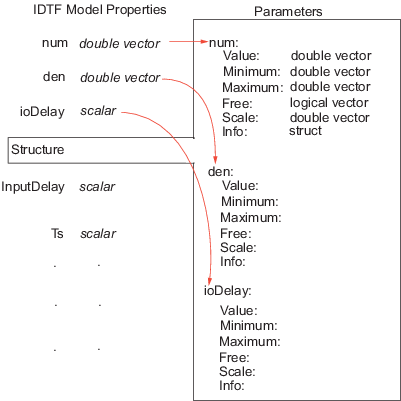Imposing Constraints on Model Parameter Values
All identified linear (IDLTI) models, except idfrd, contain a Structure property. The
Structure property contains the adjustable entities (parameters) of the
model. Each parameter has attributes such as value, minimum/maximum bounds, and free/fixed status
that allow you to constrain them to desired values or a range of values during estimation. You
use the Structure property to impose constraints on the values of various
model parameters.
The Structure property contains the essential parameters that define the
structure of a given model:
For identified transfer functions, includes the numerator, denominator, and delay parameters
For polynomial models, includes the list of active polynomials
For state-space models, includes the list of state-space matrices
For information about other model types, see the model reference pages.
For example, the following example constructs an idtf model, specifying values for the Numerator and
Denominator parameters:
num = [1 2]; den = [1 2 2]; sys = idtf(num,den)
You can update the value of the Numerator and
Denominator properties after you create the object as follows:
new_den = [1 1 10]; sys.Denominator = new_den;
To fix the denominator to the value you specified (treat its coefficients as fixed
parameters), use the Structure property of the object as follows:
sys.Structure.Denominator.Value = new_den; sys.Structure.Denominator.Free = false(1,3);
For a transfer function model, the Numerator,
Denominator, and IODelay model properties are simply
pointers to the Value attribute of the corresponding parameter in the
Structure property.

Similar relationships exist for other model structures. For example, the
A property of a state-space model contains the double value of the state
matrix. It is an alias to the A parameter value stored in
Structure.A.Value.